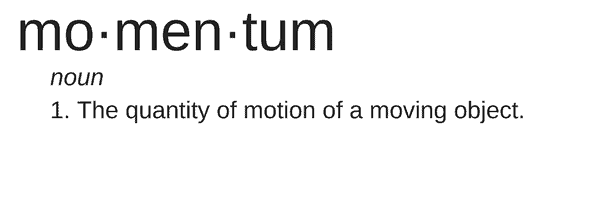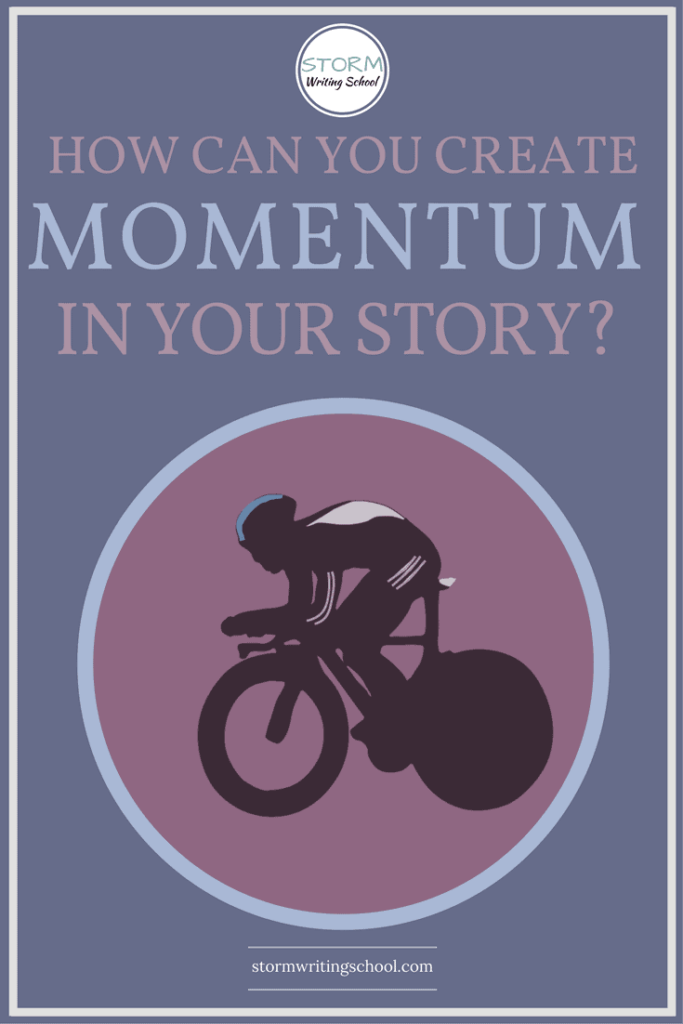

Okay, so I have a penchant toward overly-involved analogies. (I once researched the physics of vibrating strings for an hour to see if an analogy would work; I discovered it wouldn’t.) But bear with me on this one. I think it works.
Momentum is, as the definition above says, “The quantity of motion of a moving object.” Another way of saying it: once an object is in motion, it will be harder to stop if it has a large “quantity of motion.” It can get that quantity through speed (a bullet) or mass (a train). Now, I think everyone has a sense of what momentum means in storytelling, but let’s dig a bit deeper. It is a metaphor that holds up well to the Physics definition of momentum as mass x velocity.
How does a story gain mass?
As soon as a collection of words becomes a story, it gains mass. It becomes a thing that the brain recognizes as different from other collections of words.
See, the human brain processes narrative differently than it processes information. When we read information, various language processing areas of our brains light up—specifically Broca’s area and Wernicke’s area. But when we read a story, areas associated with experience light up, too—the motor cortex, for instance, or various sensory responses. And what’s more, some studies have found that when a storyteller tells a story, the listener’s brain activity starts to match the teller’s activity. The listener’s emotions and thoughts sync with the teller’s.
According to our brains, then, story is different from other forms of information. What is it that makes a story a thing, that gives it “mass”?
I posit that at minimum, a story is composed of a character moving towards a goal and facing conflict. Character, action, goal, conflict. Those are the minimal necessary components of a story—the base ingredients for the “moving object” that is story.
But a story gains more mass when the reader cares about those elements. When we empathize with the character, when we root for her goal or desire, and when we worry about the conflicts she faces, we invest emotionally in the story. And that emotional investment adds to the story mass.
If the reader cannot feel the desire and conflict on the page, in fact, the mass will fade like a dying star. I edit a lot of fiction manuscripts, and time and time again, I find myself commenting on how the writer has handled desire and conflict. Poetic passages cannot make up for a lack of desire and conflict. Creative metaphors, complex backstory, inventive world-building—none of that can carry a story. It’s not that such things don’t do anything for a story, but just as a car’s engine cannot be composed of glass and plastic and whatever else goes into the outer layers of your vehicle, you cannot have the story’s engine be made up of beautiful language and amusing character sketches.
How does a story gain velocity?
Velocity comes through motion, and motion = action. Stuff needs to happen in a story. We need to see the character actually do things, not just sit and think. And in the same way that the listener’s brain activity goes into sync with a storyteller’s, the reader’s experience of movement and speed depends on some movement within the story.
This is not to say that only high-action stories move with velocity. Again, it’s a matter of the reader caring about what’s happening in the story. If the reader cares about the action and is compelled to feel that the outcomes are consequential, then the story (or the scene/part of the story) will move very quickly. A character drinks a can of Coke. That’s action, but so what? Well, in Cormac McCarthy’s The Road, that can of Coke is among the last in the world, and the father insists that his son drink it because, as the son intuits, “It’s because I won’t ever get to drink another one, isn’t it?”
In fact, it’s often the non-action stuff—interiority, information, and the past—that gets me to really care about the characters and their goals and conflicts.
I posit that a story’s speed = the perceived quickness with which the story moves—quickness that results from action with consequence and meaning. It may not literally take me longer to read a 10-page excerpt from a novice writer, but it often feels much longer than a 10-page excerpt from a seasoned storyteller.
How do writers stop momentum?
First and foremost, if you aren’t making desire and conflict clear and compelling for your reader—constantly—you’re going to slow your momentum. If your character is not compelling enough, you’ll stall things, too. Those are the fundamentals. Make sure you always have your eyes on character, conflict, and desire.
But a story is a timeline of events, and writers can slow momentum when they mess up that timeline. Let’s come back to our car analogy. You might have all the right parts, but if you can’t assemble them correctly, that car will not run.
So a big part of creating momentum has to do with puzzling the story together, making sure that characters’ actions and reactions are not random but are consistent with their character and earlier events, making sure that every setup has a payoff and every payoff has a setup.
But it’s also a question of not appearing contrived. A story has the power to be a vicarious experience for a reader, but if the reader is aware that a story is being told, then the whole experience will feel less authentic and therefore unreal. The illusion will come tumbling down.
Learn how to create story momentum
For several years, I taught a class on story momentum at a writing retreat. In this past year, I’ve sifted through that class, revising it extensively, and adapting it to an online format. Over the course of 41 short video lectures, I walk you through all of the above in detail. In six units, I discuss
- The key elements of story
- Using desire to build scenes
- Getting tension on every page via conflict
- Juggling action and inaction to increase momentum
- Controlling pacing to maximize speed
- Creating a seamless whole via arrangement of setup and payoff
You’ll get 25 handouts, including various exemplar readings; targeted homework assignments, designed to help you put to practice the lessons of the course; some game-changing conceptualizations; and meaningful feedback from a tough but compassionate instructor.
Story momentum is of paramount importance to any storyteller.
Email me with any questions. You have lifetime access to the course, and if you are unhappy within the first 30 days of signing up, you can get a full refund. Sign up!
See what others have said:
“Tim’s interest in interacting with his participants situates Story Momentum miles above other writing craft resources. His video lectures are engaging, efficient, and spot-on satisfying in addressing burning issues the writer is facing. He means it when he says he’ll listen to your questions, and he truly is just an email away. His mastery of story craft allows him to place a name to that which the writer, too close to the work, can’t easily describe. The outcome of Story Momentum in not just a polished creative piece, but a polished creator.” -Tricia Wagner
“TD Storm’s excellent online class, Story Momentum, helps writers supercharge their stories. There are no dry, ho-hum lessons here. Tim uses short stories, novel excerpts, film clips and even music tracks to illustrate momentum in story-telling. The workbooks and challenges help writers to apply what they’ve learned, and the intensive option gives the opportunity for even more extensive feedback from Tim.” -Suzanne Samuels
SaveSave
SaveSave
SaveSave
SaveSave
SaveSave
SaveSave
SaveSave
SaveSave
SaveSave
SaveSave
SaveSave





One Response